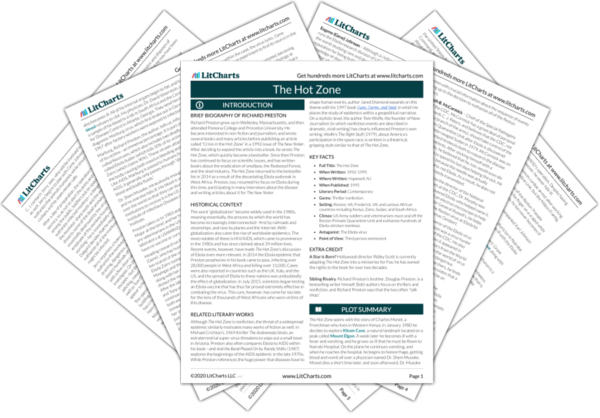Summary
Analysis
On November 28th, Tom Geisbert gets up at 4 AM and drives to Fort Detrick. He slices pieces of monkey liver with the diamond knife, puts them under his microscope, and takes photographs of the virus particles within the liver. This confirms that the viruses are coming from the Reston monkeys rather than from outside contamination. He takes his photographs to Peter Jahrling and C. J. Peters, and the three men now must wait for Jahrling to complete his tests to see whether the strain really is Marburg.
Despite the possibility that Tom Geisbert has been exposed to the virus, he remains diligent and ready to perform his duty. Time, meanwhile, yet again becomes an obstacle in the fight against Ebola/Marburg, since the scientists must waste precious days waiting for lab results before they can begin combating the virus.
Themes
As he works on his tests, Peter Jahrling decides that he must notify Dan Dalgard—but at the same time, he must make sure not to cause panic. On the phone he tells Dalgard that the monkeys definitely have simian hemorrhagic fever, but that they might also have another disease. Dalgard demands to know what it is, but Jahrling refuses to tell him. Dalgard begins to suspect, however, that the monkeys might have Marburg. When Dalgard confronts Jahrling with the possible diagnosis, Jahrling says that the second virus is most likely not Marburg, but that Dalgard and his employees should try not to expose themselves unnecessarily. Upset, Dalgard asks when they will know for sure. Jahrling promises to call him back later that day.
The question of the public and the delicacy of human relations again comes to the forefront as Peter Jahrling tries to alert Dan Dalgard to the potential danger of the virus—without also sending him into a panic. This decision is a difficult one—on one hand, more knowledge helps to keep people safe (and ignorance can be deadly, as the narrative makes clear), while on the other hand, mass hysteria is itself a dangerous and powerful force. Thus the scientists at USAMRIID must toe the line between openness and secrecy.
Themes
Shaken, Dan Dalgard considers the possibilities if the virus is indeed Marburg. He reassures himself by remembering that he has been autopsying monkeys since October, but has not fallen ill. He calls Bill Volt and orders him not to open up any more monkeys, then waits for a phone call from Peter Jahrling. As he does, he wonders whether any of his employees have cut themselves with scalpels while dissecting the sick monkeys. He begins thinking about the symptoms of Marburg, and at 5:30 finally calls Jahrling, but is unable to reach him. Annoyed, Dalgard heads home.
As this passage makes clear, equally terrifying to the symptoms of Marburg are the various human errors that can lead to contracting the virus. Dalgard’s obsession with the danger he and his employees face may seem paranoid or melodramatic, but it is in fact quite reasonable given the circumstances.
Themes
As Dan Dalgard waits and worries, Peter Jahrling works in his spacesuit. He plans to combine samples of the virus with the blood serum of humans who have died of different strains of Ebola. If a combination glows under ultraviolet light, that will confirm that the viruses match. He is using three different serums: that of Dr. Shem Musoke, who survived Marburg; that of a man named Boniface who died of Ebola Sudan; and that of Nurse Mayinga, who died of Ebola Zaire. When the results are finally ready, Peter Jahrling looks through his microscope at the samples. The Musoke doesn’t glow at all; the Boniface glows slightly; the Mayinga’s glow is bright. This means that the monkeys in Reston do not have Marburg—they have Ebola Zaire. Horrified, Peter Jahrling stands for a moment, frozen, listening to the beat of his own heart.
As he often does, in this section Preston mixes scientific fact with human emotion. The terrifying nature of Ebola Zaire is hammered home by the reaction of the usually calm, cool, and collected Jahrling, as he realizes that he may have been exposed to one of the most lethal viruses on earth. Also at play within this passage is the concept of globalization and its positive effects. This kind of research is only possible, after all, because the tools of the modern world allow USAMRIID to maintain samples of a deadly African virus.
Themes
Get the entire The Hot Zone LitChart as a printable PDF.













